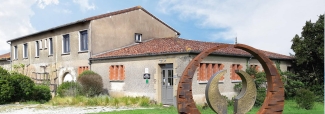
Story
THE ESTATE
In 1979, brothers Bernard, François, and Michel Couillaud purchased Château de la Ragotière, the former home of the noble family Lore de la Ragotière, who settled here in the 14th century. The founder of this line was a comrade in arms of Bertrand du Guesclin, the famed “Eagle of Brittany” of the Hundred Years’ War. The castle was destroyed during the French Revolution, but the noble family remained owner of the domain until the 19th century. Today, part of the castle moat, the remarkable porch with its antique gates, and the chapel, which has been restored as a tasting room, still remain. A multitude of vineyard plots were planted here long ago, and the estate has historically produced wines of excellent quality and outstanding aging potential. The Château de la Ragotière cellar is a precious inheritance containing vintages dating back to 1947.
THE FAMILY
Bernard, Michel, and François Couillaud were born to a family of winemakers based in Mouzillon for over 150 years. Auguste Couillaud, their grandfather, was a pioneer in the early 20th century and owned nearly 50 acres of vineyards. Leon, the brothers’ father, developed the renown of the Clos Burgundians, one of the oldest plots in Muscadet. In the early 1970s, Bernard traveled through the United States and Mexico and returned with the ambition to make the family’s wines known worldwide. While he was working with his father, he decided to sell the wine himself in bottle, a real revolution at that time. His brothers, Michel and François, were also interested in the profession, and the three brothers decided to buy Château de la Ragotière in 1979. The adventure of the Couillaud brothers began with major renovations in the winery and in the vineyards to rehabilitate the property. In 2006, the brothers welcomed the new generation: Amélie, daughter of Bernard, and her husband, Vincent Dugué. Today, Amélie and Vincent lead the estate. Amélie, who is a graduate in business and languages, handles exports, while Vincent, an agricultural engineer, is in charge of the vineyards. This new generation has introduced innovative projects such as environmentally friendly alternatives to the cultivation of the vine and the creation of a new cellar, and environmentally friendly alternatives to the cultivation of the vine for which they have received a certificate of sustainability from Terra Vitis.
THE TERROIR
The estate’s vineyards are located in the eastern portion of Vallet, one of the newly established Muscadet Crus. The soil consists of mica schists, which allow for the rapid flow of water and quick warming of the soil in spring to generate an early start for the vine. This crumbly rock also allows deep rooting of vines. Deeper down, the roots find clay areas rich in minerals, which are useful in summer to conserve water resources. The orientation of the vines, slope, soil thickness, and age of the vines varies among the plots. The vineyards are located in a maritime climate south of the Loire River, 30 miles from the Atlantic Ocean. Winters are relatively mild, which enables a fairly early start for the vines. Summers are relatively dry but with mild temperatures. The vines suffer little water stress and the balance between the sugars and acids in the berries allows for aromatic wines that retain freshness. This climate is important in creating the character of the wines and imbues them with real originality.
THE WINEMAKING
Whereas most Muscadets are left on the lees only a short time, all of the Ragotière wines are bottled sur lie. The wines are not racked after fermentation but are drawn directly off the lees and bottled immediately, leaving in the wine some of the carbon dioxide created by the fermentation. Ragotière bottles no earlier than April, allowing time for the lees to nourish the wine and define its character. In the cellar, Ragotière concentrates on bringing out the character of the wines using pneumatic pressing, cold maceration to improve aromas, and controlled-temperature fermentation and other techniques to develop body. To enable them to reach full maturity, the Muscadets are matured for about one year on fine lees.
Our Wines
| Muscadet Sur Lie Black Label |
| Muscadet Sur Lie Cuvee Amelie |
| Muscadet Sur Lie White Label |
